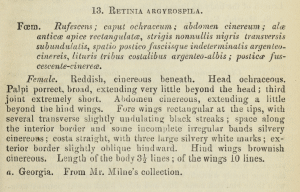

 +3Kontinente:EUNA
+3Kontinente:EUNA3. Biologie
3.1. Nahrung der Raupe
Nach Gilligan & Epstein (2014) lebt die Art polyphag an Laubgehölzen aber auch Kräutern, ausnahmsweise auch Nadelbäume. Ihre lange Liste der Host Plants umfasst Arten aus den Familien Aceraceae, Anacardiaceae, Betulaceae, Adoxaceae, Cornaceae, Ericaceae, Fabaceae, Fagaceae, Grossulariaceae, Hippocastanaceae, Hydrophyllaceae, Juglandaceae, Liliaceae, Myricaceae, Myrtaceae, Oleaceae, Pinaceae, Platanaceae, Rhamnaceae, Rosaceae, Rutaceae, Salicaceae, Tiliaceae, Ulmaceae und Vitaceae. Sie erläutern: "Archips argyrospila has been recorded from a long list of plants, many of which are not primary hosts. Under outbreak conditions the larvae feed on any plant near the primary host, and the following host list contains both primary and incidental hosts." Angaben aus Europa fehlen.
4. Weitere Informationen
4.1. Andere Kombinationen
- Retinia argyrospila Walker, 1863 [Originalkombination]
4.2. Faunistik
Walker (1863: 373) nennt "Georgia" als Herkunftsort seiner Retinia argyrospila. Die Art ist in den USA und im südlichen Kanada weit verbreitet und galt dort als Schädling. Gilligan & Epstein (2014) führen die Art bei den [Tortricids of Agricultural Importance"]: "During the first half of the 20th century, outbreaks of A. argyrospila would completely defoliate large areas of vegetation. The species was brought under control with the introduction of pesticides in the mid-1950's." Sie schreiben zur Verbreitung: "Archips argyrospila is native to North America and is found throughout the continental United States and southern Canada."
Aus Europa ist mir nur eine Angabe bekannt: Agassiz et al. (2013: 112) führen die Art bei den "adventive species" und schreiben zu England: "One in florists shop Matlock, Derbyshire, 1984. Nearctic."
(Autor: Erwin Rennwald)
4.3. Literatur
- Agassiz, D.J.L., Beavan, S.D. & R.J. Heckford (2013): Checklist of the Lepidoptera of the British Isles. - Royal Entomological Society. 206pp.
- Erstbeschreibung: Walker, F. (1863): List of the Specimens of Lepidopterous Insects in the Collection of the British Museum 28: 287-561. London. [Digitalisat auf biodiversitylibrary.org]






